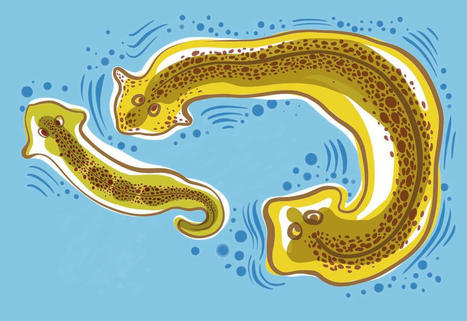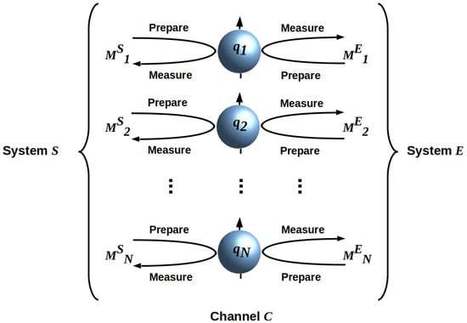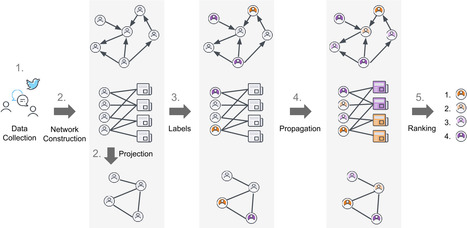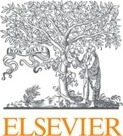 Your new post is loading...
 Your new post is loading...
Fernando E. Rosas, Bernhard C. Geiger, Andrea I Luppi, Anil K. Seth, Daniel Polani, Michael Gastpar, Pedro A.M. Mediano Understanding the functional architecture of complex systems is crucial to illuminate their inner workings and enable effective methods for their prediction and control. Recent advances have introduced tools to characterise emergent macroscopic levels; however, while these approaches are successful in identifying when emergence takes place, they are limited in the extent they can determine how it does. Here we address this limitation by developing a computational approach to emergence, which characterises macroscopic processes in terms of their computational capabilities. Concretely, we articulate a view on emergence based on how software works, which is rooted on a mathematical formalism that articulates how macroscopic processes can express self-contained informational, interventional, and computational properties. This framework establishes a hierarchy of nested self-contained processes that determines what computations take place at what level, which in turn delineates the functional architecture of a complex system. This approach is illustrated on paradigmatic models from the statistical physics and computational neuroscience literature, which are shown to exhibit macroscopic processes that are akin to software in human-engineered systems. Overall, this framework enables a deeper understanding of the multi-level structure of complex systems, revealing specific ways in which they can be efficiently simulated, predicted, and controlled. Read the full article at: arxiv.org
Victor Maull , Jordi Pla Mauri , Nuria Conde Pueyo and Ricard Solé JRS Interface February 2024 Volume 21 Issue 211 The idea that the Earth system self-regulates in a habitable state was proposed in the 1970s by James Lovelock, who conjectured that life plays a self-regulatory role on a planetary-level scale. A formal approach to such hypothesis was presented afterwards under a toy model known as the Daisyworld. The model showed how such life-geosphere homeostasis was an emergent property of the system, where two species with different properties adjusted their populations to the changing external environment. So far, this ideal world exists only as a mathematical or computational construct, but it would be desirable to have a real, biological implementation of Lovelock’s picture beyond our one biosphere. Inspired by the exploration of synthetic ecosystems using genetic engineering and recent cell factory designs, here we propose a possible implementation for a microbial Daisyworld. This includes: (i) an explicit proposal for an engineered design of a two-strain consortia, using pH as the external, abiotic control parameter and (ii) several theoretical and computational case studies including two, three and multiple species assemblies. The special alternative implementations and their implications in other synthetic biology scenarios, including ecosystem engineering, are outlined. Read the full article at: royalsocietypublishing.org
Tiny clumps of cells show basic cognitive abilities, and some animals can remember things after losing their head
Read the full article at: www.scientificamerican.com
Chris Fields, James F. Glazebrook, and Michael Levin Entropy 2024, 26(3), 194 The ideas of self-observation and self-representation, and the concomitant idea of self-control, pervade both the cognitive and life sciences, arising in domains as diverse as immunology and robotics. Here, we ask in a very general way whether, and to what extent, these ideas make sense. Using a generic model of physical interactions, we prove a theorem and several corollaries that severely restrict applicable notions of self-observation, self-representation, and self-control. We show, in particular, that adding observational, representational, or control capabilities to a meta-level component of a system cannot, even in principle, lead to a complete meta-level representation of the system as a whole. We conclude that self-representation can at best be heuristic, and that self models cannot, in general, be empirically tested by the systems that implement them. Read the full article at: www.mdpi.com
Sonia Kéfi, Alexandre Génin, Angeles Garcia-Mayor, Emilio Guirado, Juliano S. Cabral, Miguel Berdugo, Josquin Guerber, Ricard Solé, and Fernando T. Maestre The spatial structure of vegetation in dryland ecosystems has long fascinated scientists due to its striking appearance. Through a combination of global field surveys, mathematical models, and remote sensing, we show that the mechanisms responsible for these patterns enable healthy dryland ecosystems to adapt to changing environmental conditions, including water shortages, by adjusting their spatial structure. Conversely, degraded ecosystems do not have this ability. Our findings underscore the critical role of spatial pattern formation in promoting resilience in dryland ecosystems. Moreover, these spatial patterns could serve as valuable indicators of ecosystem health under a changing climate, opening important perspectives for future research in this field. Read the full article at: www.pnas.org
Hiroki Sayama, Chrystopher L. Nehaniv The year of 2024 marks the 25th anniversary of the publication of evoloops, an evolutionary variant of Chris Langton's self-reproducing loops which proved that Darwinian evolution of self-reproducing organisms by variation and natural selection is possible within deterministic cellular automata. Over the last few decades, this line of Artificial Life research has since undergone several important developments. Although it experienced a relative dormancy of activities for a while, the recent rise of interest in open-ended evolution and the success of continuous cellular automata models have brought researchers' attention back to how to make spatio-temporal patterns self-reproduce and evolve within spatially distributed computational media. This article provides a review of the relevant literature on this topic over the past 25 years and highlights the major accomplishments made so far, the challenges being faced, and promising future research directions. Read the full article at: arxiv.org
Linghang Sun, Yifan Zhang, Cristian Axenie, Margherita Grossi, Anastasios Kouvelas, Michail A. Makridis Major cities worldwide experience problems with the performance of their road transportation systems. The continuous increase in traffic demand presents a substantial challenge to the optimal operation of urban road networks and the efficiency of traffic control strategies. Although robust and resilient transportation systems have been extensively researched over the past decades, their performance under an ever-growing traffic demand can still be questionable. The operation of transportation systems is widely believed to display fragile property, i.e., the loss in performance increases exponentially with the linearly increasing magnitude of disruptions, which undermines their continuous operation. The risk engineering community is now embracing the novel concept of (anti-)fragility, which enables systems to learn from historical disruptions and exhibit improved performance as disruption levels reach unprecedented magnitudes. In this study, we demonstrate the fragile nature of road transportation systems when faced with either demand or supply disruptions. First, we conducted a rigorous mathematical analysis to theoretically establish the fragile nature of the systems. Subsequently, by taking into account real-world stochasticity, we implemented a numerical simulation with realistic network data to bridge the gap between the theoretical proof and the real-world operations, to study the impact of uncertainty on the fragile property of the systems. This work aims to help researchers better comprehend the necessity to explicitly consider antifragile design toward the application of future traffic control strategies, coping with constantly growing traffic demand and subsequent traffic accidents. Read the full article at: arxiv.org
Len Fisher, Thilo Gross, Helmut Hillebrand, Anders Sandberg, Hiroki Sayama People and NatureMany of the global challenges that confront humanity are interlinked in a dynamic complex network, with multiple feedback loops, nonlinear interactions and interdependencies that make it difficult, if not impossible, to consider individual threats in isolation.
These challenges are mainly dealt with, however, by considering individual threats in isolation (at least in political terms). The mitigation of dual climate and biodiversity threats, for example, is linked to a univariate 1.5°C global warming boundary and a global area conservation target of 30% by 2030.
The situation has been somewhat improved by efforts to account for interactions through multidimensional target setting, adaptive and open management and market-based decision pathways.
But the fundamental problem still remains—that complex systems such as those formed by the network of global threats have emergent properties that are more than the sum of their parts. We must learn how to deal with or live with these properties if we are to find effective ways to cope with the threats, individually and collectively.
Here, we argue that recent progresses in complex systems research and related fields have enhanced our ability to analyse and model such entwined systems to the extent that it offers the promise of a new approach to sustainability. We discuss how this may be achieved, both in theory and in practice, and how human cultural factors play an important but neglected role that could prove vital to achieving success. Read the full article at: besjournals.onlinelibrary.wiley.com
JUNWEI SU and PETER MARBACH Advances in Complex Systems Vol. 26, No. 06, 2340004 (2023) Empirical studies have consistently demonstrated the presence of a core–periphery structure within social network communities. Nevertheless, a formal model and comprehensive analysis to fully understand the structural characteristics of these communities are still lacking. This paper seeks to characterize these properties, focusing on agents’ interconnections and their allocation of rates. Employing a game-theoretic approach, our analysis unveils several novel insights. First, we show that periphery agents not only follow core agents but also other periphery agents who share similar primary interests. Second, our results illuminate the emergence of core–periphery communities, revealing the conditions under which they form, and how they form. Read the full article at: www.worldscientific.com
Lucila G. Alvarez-Zuzek, Jelena Grujic, Riccardo Gallotti Sharing misinformation threatens societies as misleading news shapes the risk perception of individuals. We witnessed this during the COVID-19 pandemic, where misinformation undermined the effectiveness of stay-at-home orders, posing an additional obstacle in the fight against the virus. In this research, we study misinformation spreading, reanalyzing behavioral data on online sharing, and analyzing decision-making mechanisms using the Drift Diffusion Model (DDM). We find that subjects display an increased instinctive inclination towards sharing misleading news, but rational thinking significantly curbs this reaction, especially for more cautious and older individuals. Using an agent-based model, we expand this individual knowledge to a social network where individuals are exposed to misinformation through friends and share (or not) content with probabilities driven by DDM. The natural shape of the Twitter network provides a fertile ground for any news to rapidly become viral, yet we found that limiting users' followers proves to be an appropriate and feasible containment strategy. Read the full article at: arxiv.org

|
Suggested by
Fil Menczer
|
Bao Tran Truong, Oliver Melbourne Allen & Filippo Menczer
EPJ Data Science volume 13, Article number: 10 (2024) The spread of misinformation poses a threat to the social media ecosystem. Effective countermeasures to mitigate this threat require that social media platforms be able to accurately detect low-credibility accounts even before the content they share can be classified as misinformation. Here we present methods to infer account credibility from information diffusion patterns, in particular leveraging two networks: the reshare network, capturing an account’s trust in other accounts, and the bipartite account-source network, capturing an account’s trust in media sources. We extend network centrality measures and graph embedding techniques, systematically comparing these algorithms on data from diverse contexts and social media platforms. We demonstrate that both kinds of trust networks provide useful signals for estimating account credibility. Some of the proposed methods yield high accuracy, providing promising solutions to promote the dissemination of reliable information in online communities. Two kinds of homophily emerge from our results: accounts tend to have similar credibility if they reshare each other’s content or share content from similar sources. Our methodology invites further investigation into the relationship between accounts and news sources to better characterize misinformation spreaders. Read the full article at: epjdatascience.springeropen.com
Thomas F. Varley, Joshua Bongard There has recently been an explosion of interest in how "higher-order" structures emerge in complex systems. This "emergent" organization has been found in a variety of natural and artificial systems, although at present the field lacks a unified understanding of what the consequences of higher-order synergies and redundancies are for systems. Typical research treat the presence (or absence) of synergistic information as a dependent variable and report changes in the level of synergy in response to some change in the system. Here, we attempt to flip the script: rather than treating higher-order information as a dependent variable, we use evolutionary optimization to evolve boolean networks with significant higher-order redundancies, synergies, or statistical complexity. We then analyse these evolved populations of networks using established tools for characterizing discrete dynamics: the number of attractors, average transient length, and Derrida coefficient. We also assess the capacity of the systems to integrate information. We find that high-synergy systems are unstable and chaotic, but with a high capacity to integrate information. In contrast, evolved redundant systems are extremely stable, but have negligible capacity to integrate information. Finally, the complex systems that balance integration and segregation (known as Tononi-Sporns-Edelman complexity) show features of both chaosticity and stability, with a greater capacity to integrate information than the redundant systems while being more stable than the random and synergistic systems. We conclude that there may be a fundamental trade-off between the robustness of a systems dynamics and its capacity to integrate information (which inherently requires flexibility and sensitivity), and that certain kinds of complexity naturally balance this trade-off. Read the full article at: arxiv.org
Dan Rockmore Mathematical models power our civilization—but they have limits. Read the full article at: www.newyorker.com
|
R Alexander Bentley, Benjamin Horne, Joshua Borycz, Simon Carrignon, Garriy Shteynberg, Blai Vidiella, Sergi Valverde, and Michael J O’Brien Adaptive Behavior Volume 32, Issue 2 Diversity of expertise is inherent to cultural evolution. When it is transparent, diversity of human knowledge is useful; when social conformity overcomes that transparency, “expertise” can lead to divisiveness. This is especially true today, where social media has increasingly allowed misinformation to spread by prioritizing what is recent and popular, regardless of validity or general benefit. Whereas in traditional societies there was diversity of expertise, contemporary social media facilitates homophily, which isolates true subject experts from each other and from the wider population. Diversity of knowledge thus becomes social division. Here, we discuss the potential of a cultural-evolutionary framework designed for the countless choices in contemporary media. Cultural-evolutionary theory identifies key factors that determine whether communication networks unify or fragment knowledge. Our approach highlights two parameters: transparency of information and social conformity. By identifying online spaces exhibiting aggregate patterns of high popularity bias and low transparency of information, we can help define the “safe limits” of social conformity and information overload in digital communications. Read the full article at: journals.sagepub.com
Lucas Böttcher and Mason A. Porter Phys. Rev. E 109, 024314 In many studies, it is common to use binary (i.e., unweighted) edges to examine networks of entities that are either adjacent or not adjacent. Researchers have generalized such binary networks to incorporate edge weights, which allow one to encode node–node interactions with heterogeneous intensities or frequencies (e.g., in transportation networks, supply chains, and social networks). Most such studies have considered real-valued weights, despite the fact that networks with complex weights arise in fields as diverse as quantum information, quantum chemistry, electrodynamics, rheology, and machine learning. Many of the standard network-science approaches in the study of classical systems rely on the real-valued nature of edge weights, so it is necessary to generalize them if one seeks to use them to analyze networks with complex edge weights. In this paper, we examine how standard network-analysis methods fail to capture structural features of networks with complex edge weights. We then generalize several network measures to the complex domain and show that random-walk centralities provide a useful approach to examine node importances in networks with complex weights. Read the full article at: link.aps.org
Thomas F. Varley, Olaf Sporns, Nathan J. Stevenson, Martha G. Welch, Michael M. Myers, Sampsa Vanhatalo, Anton Tokariev The human brain is a complex organ comprising billions of interconnected neurons which enables interaction with both physical and social environments. Neural dynamics of the whole brain go far beyond just the sum of its individual elements; a property known as “synergy”. Previously it has been shown that synergy is crucial for many complex brain functions and cognition, however, it remains unknown how and when the large number of discrete neurons evolve into the unified system able to support synergistic interactions. Here we analysed high-density electroencephalography data from late fetal to early postnatal period. We found that the human brain transitions from redundancy-dominated to synergy-dominated system around birth. Frontal regions lead the emergence of a synergistic scaffold comprised of overlapping subsystems, while the integration of sensory areas developed gradually, from occipital to central regions. Strikingly, early developmental trajectories of brain synergy were modulated by environmental enrichment associated with enhanced mother-infant interactions, and the level of synergy near term equivalent age was associated with later neurocognitive development Read the full article at: www.biorxiv.org
F. Al Reda, S. Faure, B. Maury, E. Pinsard Journal of Computational Physics
• Numerical investigation of the Faster is Slower effect based on a parameter free model.
• Integration of an inhibition tendency of polite pedestrians. • Numerical evidence of the fluidizing role of an obstacle upstream the exit during evacuation. • Numerical recovering of an experimental power law for time lapses. Read the full article at: www.sciencedirect.com
Špela Šalamon Andrew Ewing Greta Fox Stephane Bilodeau Carlos Gershenson Matti TJ Heino Yaneer Bar-Yam WHN Science Communications 2024; 5 (1): 1-1. The global impact of the COVID-19 pandemic persists, causing significant harm. Extensive evidence indicates that even mild infections and reinfections can result in symptomatic and subclinical health damage, disability, and persistent infection. Vascular impacts, neurotropism, and immune dysregulation lead to impaired organ function, increased morbidity and mortality, compromised work productivity, and a decline in overall health and quality of life. The uncontrolled spread of the virus is accelerating its evolution, outpacing the effectiveness of vaccines, treatments, and immune system adaptation. This preventable disease and others magnified by immune dysfunction are driving staff shortages, supply chain disruptions, and overwhelming healthcare systems. Despite the dire nature of the current conditions, knowledge and means are present to solve these problems. We present a science-based strategy for confronting the ongoing pandemic, including reducing airborne transmission through clean indoor air programs comparable with historical clean water programs. Public and professional education on the implications of repeated SARS-CoV-2 infections and utilizing known preventive measures can dramatically reduce transmission, which in turn reduces the rate of new variant introduction and strengthens the effectiveness of vaccines and treatments. It is essential to restore the prioritization of health and safety in healthcare and society. Read the full article at: whn.global
Maria Cristina Diamantini Entropy 2023, 25(7), 984 In this review, we establish a relation between information erasure and continuous phase transitions. The order parameter, which characterizes these transitions, measures the order of the systems. It varies between 0, when the system is completely disordered, and 1, when the system is completely ordered. This ordering process can be seen as information erasure by resetting a certain number of bits to a standard value. The thermodynamic entropy in the partially ordered phase is given by the information-theoretic expression for the generalized Landauer bound in terms of error probability. We will demonstrate this for the Hopfield neural network model of associative memory, where the Landauer bound sets a lower limit for the work associated with ‘remembering’ rather than ‘forgetting’. Using the relation between the Landauer bound and continuous phase transition, we will be able to extend the bound to analog computing systems. In the case of the erasure of an analog variable, the entropy production per degree of freedom is given by the logarithm of the configurational volume measured in units of its minimal quantum. Read the full article at: www.mdpi.com
Tomoko Sakiyama Physica Scripta Random Boolean Networks (RBNs) model complex networks with numerous variables, serving as a tool for gene expression and genetic regulation modeling. RBNs exhibit phase transitions, contingent on node degrees. Given the significance of phase transitions in collective behaviors, the study explores the relationship between RBNs and actual living system networks, which also display critical behaviors. Notably, living systems exhibit such behaviors even beyond the predicted critical point in RBNs. This paper introduces a novel RBNs model incorporating a rewiring process for edge connections/disconnections. In contrast to prior studies, our model includes artificial genes occasionally adding self-loops and creating an instant and temporal lookup table. Consequently, our proposed model demonstrates the edge of chaos at higher node degrees. It serves as an abstract RBNs model generating noisy behaviors from internal agent processes without external parameter tuning. Read the full article at: iopscience.iop.org
Germans Savcisens, Tina Eliassi-Rad, Lars Kai Hansen, Laust Hvas Mortensen, Lau Lilleholt, Anna Rogers, Ingo Zettler & Sune Lehmann
Nature Computational Science volume 4, pages 43–56 (2024 Here we represent human lives in a way that shares structural similarity to language, and we exploit this similarity to adapt natural language processing techniques to examine the evolution and predictability of human lives based on detailed event sequences. We do this by drawing on a comprehensive registry dataset, which is available for Denmark across several years, and that includes information about life-events related to health, education, occupation, income, address and working hours, recorded with day-to-day resolution. We create embeddings of life-events in a single vector space, showing that this embedding space is robust and highly structured. Our models allow us to predict diverse outcomes ranging from early mortality to personality nuances, outperforming state-of-the-art models by a wide margin. Using methods for interpreting deep learning models, we probe the algorithm to understand the factors that enable our predictions. Our framework allows researchers to discover potential mechanisms that impact life outcomes as well as the associated possibilities for personalized interventions. Read the full article at: www.nature.com
JINLONG MA, TINGTING XIANG, and MINGWEI CAI Advances in Complex Systems Vol. 26, No. 06, 2340005 (2023) Multiplex networks have proven to be valuable tools for modeling and analyzing real complex system. Extensive work has been done on the traffic dynamics on multiplex networks, but there remains a lack of sufficient attention towards studying routing strategies for the purpose of suppressing epidemic spreading. In this paper, the impact of global awareness routing (GAR), improved global awareness routing (IGAR), and improved active routing (IAR) strategies on traffic-driven epidemic spreading are investigated. Our findings indicate that in the case of infinite node-delivery capacity and no traffic congestion in the network, adjusting routing parameters can effectively suppress epidemic spreading. In this context, these three strategies show better abilities on the multiplex network built by WS or ER model to minimize the density of infected nodes, thus contributing to the overall inhibition of the epidemic spread. However, in the multiplex network constructed by BA model, GAR strategy has a promoting effect on epidemic spreading compared with the shortest routing strategy. In addition, by controlling traffic flow, limiting node delivery capabilities can contain outbreaks. Our results suggest that adopting appropriate routing strategies in multiplex networks can play a proactive role in controlling epidemic spreading. This is crucial for formulating effective prevention and control measures and improving public health security. Read the full article at: www.worldscientific.com
Federica De Domenico, Fabio Caccioli, Giacomo Livan, Guido Montagna, Oreste Nicrosini Participants in socio-economic systems are often ranked based on their performance. Rankings conveniently reduce the complexity of such systems to ordered lists. Yet, it has been shown in many contexts that those who reach the top are not necessarily the most talented, as chance plays a role in shaping rankings. Nevertheless, the role played by chance in determining success, i.e., serendipity, is underestimated, and top performers are often imitated by others under the assumption that adopting their strategies will lead to equivalent results. We investigate the tradeoff between imitation and serendipity in an agent-based model. Agents in the model receive payoffs based on their actions and may switch to different actions by either imitating others or through random selection. When imitation prevails, most agents coordinate on a single action, leading to non-meritocratic outcomes, as a minority of them accumulates the majority of payoffs. Yet, such agents are not necessarily the most skilled ones. When serendipity dominates, instead, we observe more egalitarian outcomes. The two regimes are separated by a sharp transition, which we characterise analytically in a simplified setting. We discuss the implications of our findings in a variety of contexts, ranging from academic research to business. Read the full article at: arxiv.org
María del Pilar García-Chitiva, Juan C. Correa Is it possible to measure how critical soft skills like leadership or teamwork are from the viewpoint of graduate studies offerings? This paper provides a conceptual and methodological framework that introduces the concept of a bipartite network as a practical way to estimate the importance of soft skills as socio-emotional abilities trained in graduate studies. We examined 230 graduate programs offered by 49 higher education institutions in Colombia to estimate the empirical importance of soft skills from the viewpoint of graduate studies offerings. The results show that: a) graduate programs in Colombia share 31 soft skills in their intended learning outcomes; b) the centrality of these skills varies as a function of the graduate program, although this variation was not statistically significant; and c) while most central soft skills tend to be those related to creativity (i.e., creation or generation of ideas or projects), leadership (to lead or teamwork), and analytical orientation (e.g., evaluating situations and solving problems), less central were those related to empathy (i.e., understanding others and acknowledgment of others), ethical thinking, and critical thinking, posing the question if too much emphasis on most visible skills might imply an unbalance in the opportunities to enhancing other soft skills such as ethical thinking. Read the full article at: arxiv.org
Ahmad, M.A.; Baryannis, G.; Hill, R Systems 2024, 12(2), 45 Despite a profusion of literature on complex adaptive system (CAS) definitions, it is still challenging to definitely answer whether a given system is or is not a CAS. The challenge generally lies in deciding where the boundaries lie between a complex system (CS) and a CAS. In this work, we propose a novel definition for CASs in the form of a concise, robust, and scientific algorithmic framework. The definition allows a two-stage evaluation of a system to first determine whether it meets complexity-related attributes before exploring a series of attributes related to adaptivity, including autonomy, memory, self-organisation, and emergence. We demonstrate the appropriateness of the definition by applying it to two case studies in the medical and supply chain domains. We envision that the proposed algorithmic approach can provide an efficient auditing tool to determine whether a system is a CAS, also providing insights for the relevant communities to optimise their processes and organisational structures. Read the full article at: www.mdpi.com
|



 Your new post is loading...
Your new post is loading...












